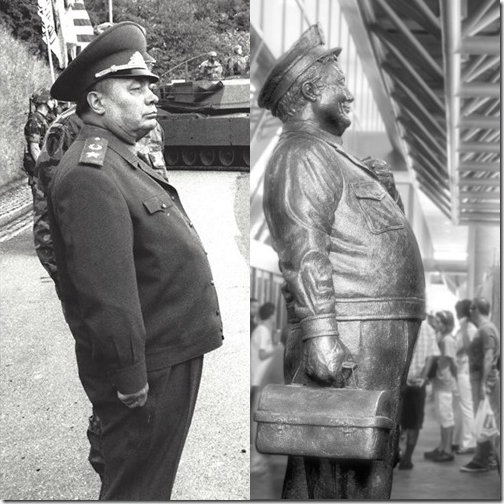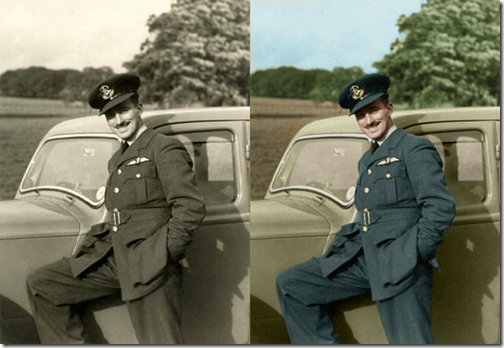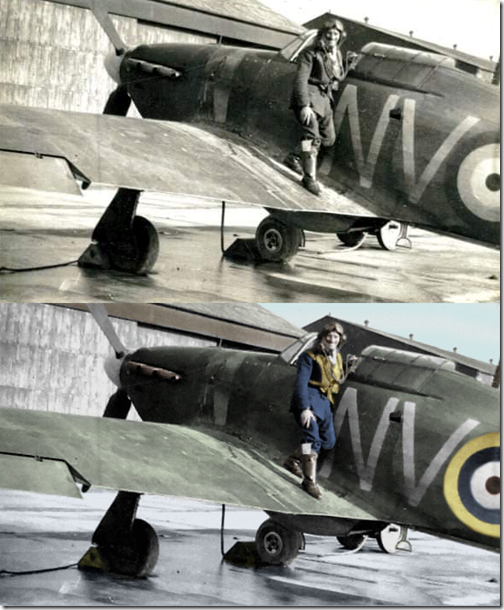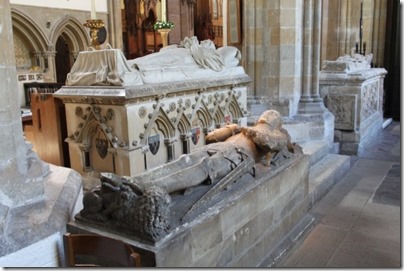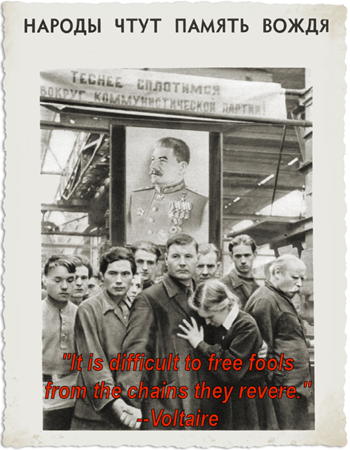General Snetkov versus Ralph Kramden
03 March 2020 • by Bob • History, Military, Humor
I've shared on here before about how I had been COL Abrams' translator on the DDR border when GEN Snetkov (the CDR of GSFG) in the late 80s) came through. (See Sometimes You Should Shut Up And Be In The Photo about that.) But something that I don't think I shared here before was how much I thought that GEN Snetkov looked like Ralph Kramden.
Coloring Historical Photographs - First Attempt
02 February 2020 • by Bob • Photography, History
I hang out in a few history-related forums, and I see a lot of great photos posted. Periodically, I see photos that someone has colorized, and I have occasionally thought, "I wonder how hard that is?" With that in mind, I saw a photo today that I thought seemed like it would be a great place to get started. Here is the before and after... it's not too bad for a first effort. There are a few historical inaccuracies that I learned about after the fact; for example: the buttons and belt buckle both should have been silver, not brass. (I obviously have room to improve.)
Colorizing that image was quickly followed by colorizing another image, which turned out okay, but I didn't have much to work with; the resolution of the source image wasn't that great. I did some research to get the colors right for the airplane and uniform, so I was trying to learn from my mistakes.
So there you have it - my first two attempts at coloring historical images. I obviously have lots of room to grow.
Remembering the Fall of the Wall
10 November 2019 • by Bob • Politics, Military, History
Today is November 9, 2019, which is exactly 30 years since the opening of the East German border; that event has since become known as "The Fall of the Wall." I was stationed along the East German border when it was opened, and I still have vivid memories of what the world was like at that time.
Tensions in East Germany had been building for some time, and thousands of East Germans had already fled through neighboring Warsaw Pact nations like Hungary and Czechoslovakia. When the border was opened unexpectedly on November 9, 1989, hundreds of thousands of East Germans poured into West Germany, where they were met with open arms by crowds of joyous West German citizens and US military personnel.
Within a few short years, the two Germanys were reunited, and the Soviet Union collapsed - which was the greatest manifestation of Communism's many, many failures. However, as a reminder of what the border was like before it opened, you might want to watch the following video.
Just two short months ago, a small group of my fellow 511th MI Company veterans and I met for a reunion at the former
Posing by the former border towers.
Not to beat a dead horse on the subject, but this is a chunk of the East German border fence that I have had in my office for the past three decades. I personally cut that section off the fence after the border was opened, and it's a nice little reminder that the plans of evil men everywhere will eventually fail.
The text is a little blurry, but it quotes Psalm 146:7 "The Lord sets the prisoners free,"
with the dates of 13 August, 1961 to 9 November, 1989.
Minor Debates About the Shroud of Turin
09 April 2019 • by Bob • History, Religion
Someone recently posted the following challenge about the Shroud of Turin in a forum that I follow:
"When somebody explains to me without supposition what process produced the image on the cloth with the characteristics that it actually has, I'll consider it conceivable that it was produced by medieval artists. Until that's understood, calling it a medieval forgery is effectively punting; it's an argument from ignorance. Why would anybody produce a forgery manifesting some characteristic with which nobody was familiar? E.g., why would a medieval artist who'd never seen a camera produce a photographic negative? Why would a modern artist produce an image that suggests imprinting by an unknown process? Forgers work by reproducing known characteristics, not unknown ones. The truth is that no MODERN artist could produce those images, nor would any of them try, because nobody understands how they got there. This does not prove that the image is authentic, but 'medieval forgery' isn't even plausible."
I thought that this was a worthwhile challenge/question, and I've actually studied a bit about that over the years. With that in mind, I posted the following two responses:
"There have been several documentaries over the past few decades wherein various scientists and archeologists have demonstrated how to achieve the same results; see How to Fake the Shroud of Turin [from the Smithsonian Channel] for just one such example. One particular documentary that I saw on the shroud many years ago went one step further with the assertion that this technique was commonly-used by medieval sculptors to create facsimiles of statues that they had created. When potential customers would come by their shops, they could look at the facsimile images that were captured on cloth in much the same way that present-day customers might look through a catalog."
"That being said, I make no claims where the Shroud of Turin is concerned. For starters, the shroud is double-sided, which would be atypical for the facsimile theory. In addition, the body depicted on the shroud would be a rather uninspiring statue for a sculptor to have made; the subject is lying on its back and nude, so if this was a facsimile of a sculpture, there would have been a very limited number of places where it could have been displayed. It is plausible that - if this was the facsimile of a statue - then it might have been for an effigy, which would explain the recumbent position, and effigies were quite popular in the Middle Ages. However, Medieval effigies were traditionally clothed, so that would also be a problem with the statue/facsimile theory."
My response seemed to anger the original poster, and he responded with the following retort:
"Never mind how it's done. Why would a Medieval forger produce a photographic negative, having never imagined, let alone seen, a camera?"
I found his response rather confusing, because his original challenge had been to explain how a medieval artist might have created the shroud, and I had just done so. With that in mind, I responded with the following series of responses:
"Did you not read what I just wrote? Put aside all thoughts of forgeries (which I did not suggest), as well as any present-day thoughts of photography or negatives or whatever. What I mentioned was that some historians have shown that there was a method by which sculptors recorded their works. It had nothing to do with being a 'negative,' it was just a way to record their work during a time when there was no other way to do so. Creating a duplicate of a sculpture would be too costly and take up too much space, and hiring someone to draw/paint a facsimile of a sculpture would be similarly expensive and not resemble the original. Whereas, taking a rubbing of a statue would produce a facsimile of the original, and people continue to employ similar techniques around the world when they make brass rubbings or gravestone rubbings."
"One additional point of note, we tend to think of the shroud as a negative, because when someone photographed it years later, the white-on-black 'negative' of the photo appeared to be a positive (and somewhat 3D-looking) image. However, sculptors used the black-on-white technique to record their work, because the resultant image looked more like their original artwork. So for them, it was never about a negative; to them, the facsimile was exactly what they were going for. Take a look at the following image; we tend to think of the shroud as the face on the right, because it seems 'corrected' to us based on our present-day presuppositions. However, the face on the left looks like a cloth-based representation of a bas-relief sculpture. Sometimes you need to put aside your modern interpretation and look at it from the perspective of someone who lived one or two thousand years ago."
"This brings me back to why I weighed in on this discussion; you had asked for someone to explain a way that medieval artists might have created the shroud. I have pointed out that several scientists and archeologists have done just that; they have positively demonstrated HOW this was possible. What's more, several historians have described the more important question of WHY medieval artists used this technique: to record their work as a means of future advertising. The part that seems the most-difficult for you to grasp is that none of this has anything to do with your modern-day understanding of photography and negative images; the appearance of the shroud as it exists is exactly what medieval artists were trying to create."
"Just to round out the discussion, I never said that I believed the shroud was the work of forgers. Actually, I never weighed in on the veracity of the shroud at all; I was simply answering your questions with several facts that it appears you were unfamiliar with. Which leaves this discussion with the question of whether I believe the shroud is genuine or not. And my answer is - I'm not sure; there is plenty of evidence either way. But that being said, whether the shroud was the burial cloth of Jesus or a medieval artist's record of a statue is immaterial to me. I believe whole-heartedly that Jesus died and rose again, and that's what's most-important here."
Not to beat a dead horse on the subject, but here are my personal thoughts about the Shroud of Turin:
I actually lean in the direction that it might be valid, though it's more like 70/30 split for me. I've studied a lot about it over the past few decades, and I've never been convinced either way. For the longest time I was more like a 50/50 split; I simply wasn't sure at all. When the carbon dating yielded an estimate of sometime around the 13th-century, that made me lean more toward a 20/80 split; but I still wasn't fully convinced either way.
Since then I have watched several documentaries and read several articles about how the carbon dating was done incorrectly, and also about the increasing scientific analysis of chemicals in the shroud that can only be found in Israel. Armed with that knowledge my opinion has shifted more toward the veracity of the shroud than at any other time in my life.
Outside of personal word from God, I am fairly certain that I will never be fully-convinced either way. With that in mind, I have no problems sharing facts that I have learned that either corroborate or negate the shroud; I try to remain open to either possibility. But in the end, the point I made in the discussion thread is still what's most-important: I believe whole-heartedly that Jesus died and rose again, and He is my personal savior.
Or as it is written in the Nicene Creed:
"I believe in one God, the Father Almighty, Maker of all things visible and invisible;
And in one Lord Jesus Christ, the Son of God, begotten of the Father;
By whom all things were made;
Who for us men, and for our salvation, came down and was incarnate and was made man;
He suffered, and the third day he rose again, ascended into heaven;
From thence he shall come to judge the quick and the dead."
That sums up what I believe quite nicely.
Propaganda and the Death of Stalin
05 March 2019 • by Bob • History, Politics
Here is a simple thought from Voltaire on the anniversary of Josef Stalin's death: "It is difficult to free fools from the chains they revere."
The preceding image is from the time of Stalin's death, and the text above it reads, "Народы чтут память вождя," which translates as, "The people honor the memory of their leader." The mourners in that photo were obviously staged for propaganda purposes, but still - few people who haven't studied Russian history fail to realize how many Russians loved Stalin, even though he put nearly three times as many of his own citizens to death as the Nazis. Stalin's level of adulation was primarily due to the USSR's disinformation machine, which spent years elevating Stalin's cult of personality to epic proportions. For many Russians, Stalin was their hero, their savior, their loving parent, and the sole victor of WWII.
When I was studying Russian, I was once involved in a heated discussion with one of my instructors. (In Russian, of course). She had recently defected from the Soviet Union, and she had yet to learn some of the actual facts about her own country; she only knew the propaganda that she had heard in her childhood. All the other students in the class were backing my discussion points, and the instructor broke down in tears while lamentably exclaiming, "But I'm Russian! I should know my own history!" All I could say was, "Yes, you should, but you need to visit a library because you've been deceived." (It's amazing that our group of students didn't get in trouble for making an instructor cry.)
While it is inarguable that every industrialized nation - to include the US - has used propaganda to further its respective agenda, Communist nations like the USSR (and a few of its Communist allies) used a two-phase approach of propaganda together with purges in order to subdue the population.
Propaganda
Propaganda is, of course, the use of state-controlled press and media to feed a carefully-constructed narrative to the masses, and it was used with particular effectiveness in Stalinist-era Russia, the result of which was that the average Russian - the peasants, the hawkers in the streets, the poorly-educated, and the bulk of the population - actually believed the lies. And wouldn't they? The propaganda is all they knew from what little education they had, and there were no other sources of information; the press and the media were both controlled by the Communists, and those who possessed enough knowledge to put up an intelligent argument were either killed or imprisoned.
Purges
Purges were used to reduce the numbers of those who are too intelligent [and therefore a perceived threat to the state], and to terrify those left alive into silence. Stalin's purges killed an estimated 9 to 60 million people, and permanently altered the course of Eastern European history. (Of course, Stalin's Communist purges weren't the only crimes against humanity committed by Communists throughout the 20th century, but more about that later.)
Conclusion
It is an indisputable fact that the US and its allies have used some form of propaganda at one time or another, but the "state" controls neither our press nor our media, nor have we resulted to purges in order to wipe out mass segments of a dissatisfied population. As a result, we have had both the knowledge and the freedom to say, "This president sucked," or "That president sucked," or "We should vote every member of Congress out of office and start over."
However, the US has never resorted to the purges that Stalin inflicted on millions of his own people. While the US has certainly treated one group or another horrendously unfairly - such as Native Americans, Africans slaves, Japanese Americans during WWII - the US has never slaughtered millions of its citizens simply because they disagreed with whomever is in power.
POSTSCRIPT:
True confession: the impetus for this post was a social media post that I had made with the first image and the quote from Voltaire. Most people saw it for what it was meant to be - a simple observation of human nature when people have been deceived. However, one misguided individual on social media objected to my post and launched into a ludicrous defense of Communism, while at the same time condemning the US for its many heinous crimes, most of which were - in all honesty - complete fabrications. Against my better judgment, I engaged this gentleman (term used loosely and inappropriately) in a discussion, our conversation wandered through a series of topics.
One of his claims was that there was a "post-WW2 demonization of communists" that rivaled anything that Communism had wrought, and I replied that Stalin's Communist purges weren't the only crimes against humanity committed by Communists throughout the 20th century. There were Lenin's Communist purges, and Mao's Communist purges, and the North Vietnamese Communist purges, and the Cambodian Khmer Rouge's Communist purges, and Cuba's Communist purges, and the North Korea's Communist purges, and Eastern Europe's Communist purges, etc. I stated that it is a concrete statement of fact that in every state where the Communists gained power during the 20th century, whole populations of people were eradicated. Communism has emerged as the single-greatest cause of deaths in human history; more than all of the disparate diseases and wars combined. And yet, the "post-WW2 demonization of communists" that he mentioned resulted in a only handful of arrests for acts of treason or conspiring to commit treason, and a few deportations, and a few misguided defections to the east, and several pro-Communist Hollywood script writers losing their jobs.
To be blunt: if you're reading this now and you think that the post-WWII Red Scare was anywhere on the level of a Communist purge, then you have not been paying attention to history.
If the actions of a handful of leftist leaders were marginalized in the wake of WWII, that is simply a disservice to history. On the other hand, the documented deaths of over 100 million people during the Communist purges of the 20th century is a genocide of epic proportions. Once again, there is simply no comparison between the complete eradication of entire populations in the name of Communism and the meager number of arrests that were made during this period of Communist "demonization" with which this misguided individual on social media had become so fixated.
For what it's worth, I learned the Russian language from teachers who had defected from the Soviet Union, and I learned first-hand of how they had suffered under Communism. Later, I was the translator for Russian defectors in Germany during the 1980s, and I heard their personal stories of why they were forced to flee for their lives. I met and spoke with several members of the Soviet Military prior to the fall of Communism, and learned of how atrocious their living conditions were. I learned Spanish from a woman who had defected from Cuba, and she told stories of her horrifying treatment by the Communists who ruined her country. I interviewed a man who had lived 10 years in a Communist gulag, where his only crime was fighting for freedom of speech. I attended Russian schools in Western Europe that were founded by and staffed with Soviet defectors, and I listened to their lectures on the many follies and failures of Communism. One of my Russian teachers had been one of the Soviet Union's most-popular actresses in her youth, and her husband was one of the Soviet Union's most-successful directors... until they defected, and then their names were wiped clean from the pages of Russian history. She and I watched one of her movies together, where her name was stripped from the credits despite her appearance in the film, and her husband's name was removed as the director despite his work on the project. That being said, every other actor and actress involved in the film who stayed in the Soviet Union was dead - some were sent to gulags, some were arrested and never heard from again, and others killed themselves rather than continue to live under Communist rule. These people whom I have mentioned were not people from history books, these were actual Russians whom I befriended during a lifetime of studying the consequences of Communism and its caustic effects on society.
If anyone cannot see the difference between the personal sufferings that I have described and the perceived injustices that were endured by the handful of people who were described by the misguided individual with whom I was conversing, then let me be very clear: those crimes are not equal in the annals of history. Leaving someone out of the history books because you disagree with their politics is not the same as killing millions of people because you disagree with their politics.
All of this lively discussion has reminded me that it's time to watch "The Death of Stalin."
UPDATE: This post is one of several that I had written that I later discovered had never been set to "public."
Removing Confederate Statues
20 January 2019 • by Bob • History, Ponderings, Politics
There is a strange cult of personality that has grown up regarding Robert E. Lee, which has unfortunately given rise to several myths. With that in mind, let me discuss Lee with a few simple examples.
First, until the time that Benedict Arnold sold out his country, he was one of the greatest commanders in the fledgling United States Army. Arnold's skills were decidedly better than George Washington's. However, we have no monuments to Arnold, despite his long string of victories that helped establish our nation. Instead, Arnold's name has become synonymous with traitorous behavior.
In a like manner, Robert E. Lee may have been a decent commander, though perhaps not nearly at the level that modern-day mythology has portrayed him. Nevertheless, when faced with the decision of where his loyalties were, Lee turned his back on his nation in its hour of greatest need. Like Benedict Arnold, history should remember Lee for being the traitor that he certainly was.
Second, with regard to slavery, you cannot make the case that Lee opposed slavery while overlooking the facts that Lee was an outspoken racist who owned slaves, regardless of how well they may have been treated. Lee participated in the recapture of slaves, and following emancipation Lee felt that blacks were unequal to whites, blacks should not be allowed to vote, blacks lacked the intelligence to be involved in politics, and he supported plans to export African Americans to Liberia. Lee had many opportunities to speak publicly in opposition to slavery, yet he never did. Lee had many opportunities to speak publicly in opposition to racism, and he never did. Lee had many opportunities to speak publicly in favor of the rights of African Americans, and he never did.
In summary, Lee was not an American hero who is worthy of the misplaced adulation that many people have chosen to give him. Lee was not simply a product of his times - history clearly shows Lee was a traitor in every sense of the word, and racist to the core. The romantic vision that many people seem to possess of Robert E. Lee is completely undeserved.
Taking all of the preceding information into account, I do not consider the removal of public monuments to Confederate traitors - like Lee - as an attempt to "erase history," as some people claim. Personally, I believe that removing statues of men who sold out their country is finally putting history in its proper perspective. These men were traitors - not heroes. They are unworthy of public worship, and it is a great tragedy that our country is littered with dozens of shrines to the undeserving. However, their statues should be moved to museums, where people can still remember these men's treachery. If people truly wanted to "erase" these traitors from history, then we would be removing all mention of them from our history books, but that is not the case. Instead, our society is finally taking the time to correct a great injustice that has been done; we are reexamining the lives of these traitors, and removing testaments to their betrayal.
UPDATE: This post is one of several that I had written that I later discovered had never been set to "public."
The Sad Life and Strange Disappearance of Madalyn Murray O'Hair
16 October 2018 • by bob • History, Religion
Some Observations of Atheists
Throughout my life I have known my fair share of atheists, all of whom have fallen into two categories:
- Genuine Atheists - these people truly do not believe in God, and in my experience they have typically been polite people with great attitudes, and with whom anyone might want to be friends.
- Faux Atheists - these people actually believe in God, despite their protests to the contrary, and they have typically been awful people with whom most people would hate to associate.
Faux Atheists are interesting character studies, because their professed disbelief does not actually match what they appear to believe behind their gruff facade. Every Faux Atheist whom I have known is actually a believer, but they are mad at God for some perceived cause that is too severe for them to reconcile with the image of a loving, benevolent Creator. Here are the primary justifications that I have encountered for these atheists:
- Most often the source of Faux Atheists' hatred is the death of a loved one - usually an immediate family member, (e.g. a parent, spouse, sibling, or child). These atheists believe that God is the direct cause of their loved one's death, and their only recourse is to curse God incessantly.
- Fairly often the source of Faux Atheists' hatred is self-condemnation for a lifetime of bad life decisions that they have made. These Faux Atheists generally lack self-reflection, and blaming God is much easier than learning to consider their contribution to their current situation.
- Less often the source of Faux Atheists' hatred is a vain attempt to justify a lifestyle that they know is objectionable, and therefore a disbelief in God gives them the 'freedom' to do as they please. However, these atheists know deep down that they are doing something wrong, so they lash out at God in an effort to rid themselves of the guilt that they feel.
- The least often source of Faux Atheists' hatred that I have seen is the perception of persecution; these atheists believe that society is 'too religious,' and all of the 'religious' people around them are oppressing them. I am almost ashamed to admit it, but I find these atheists extremely amusing to converse with, because their claims of being a 'victim' and taunted mercilessly by the Christians around them are almost-always the by-product of a pre-existing victim mentality. These atheists invariably encounter situations where they already believe that they are being persecuted, and therefore they misinterpret everything that does not go their way as additional persecution. (Quite often a little reasoning with these atheists will deflate a situation, but sometimes they are too convinced of their misfortune to see clearly.)
All of these Faux Atheists create an interesting paradox, for despite all of these atheists' hatred and never-ending rhetoric about how terrible all the 'Religious People' are, it is usually the atheists who are behaving badly. (Please do not misunderstand me, there are plenty of 'Christians' who are also terrible people; being a terrible person is not a prerequisite for being an atheist or a Christian.) The Faux Atheists that I have known seem to make it their life's mission to publicly ridicule every Christian (and most of the Jews) they know.[1]
All of this discussion brings us to Madalyn Murray O'Hair.
Madalyn Murray O'Hair
To put it bluntly, Ms. O'Hair was a paranoid schizophrenic with delusions of grandeur. She was addicted to the acclaim that she received as a champion of radical causes. She relished her title as the 'Most-Hated Woman in America.' She founded the American Atheists (AA) organization under the guise of educating and supporting fellow atheists, but the simple truth is that she was a megalomaniac who was embezzling from her organization. There were several dramatic ironies in her life, and her erratic, abusive and paranoid behavior eventually became her undoing.
Madalyn's Earlier Years
According to a book[2] that was written by Madalyn's son, William J. Murray, Madalyn was born into a family with an alcoholic father as the patriarch, and she often fought viciously and vociferously with her father. Before entering public life, Madalyn had:
- Married young just before the onset of WWII
- Joined the Army after the war started (while her husband joined the Marines)
- Had an affair with a married officer that resulted in an out-of-wedlock child (at a time when these actions were cause for public scorn)
- Divorced her first husband hoping the officer would marry her (which he didn't)
- Had another relationship that resulted in an out-of-wedlock child
According to Madalyn's son, each of these poor decisions were the source of countless family arguments.
Madalyn's children subjected the extended family to additional financial strains and care-giving necessities, which were largely ignored by Madalyn. Adding insult to injury, Madalyn could not keep any job for longer than a few months; she was continuously forced to leave one job after another because she felt that everyone above her was stupid, and she needed to be in charge. Her attitudes may have angered her bosses, but some of Madalyn's proclamations of her superiority found welcome recipients among her coworkers, which led to Madalyn embracing Socialism and Communism. Meanwhile, Madalyn began to work her way through law school by taking classes on the side, and even though she graduated, she never passed the bar exam. As a result, she remained in a long line of dead-end jobs, and her extended family was forced to live in decrepit, low-income housing.
According to William, it was during this time period that Madalyn formulated her special brand of atheism, and it was shortly thereafter that she would infamously enter public life.
The 'Most-Hated Woman in America'
In 1963, Madalyn sued the Baltimore public school system, where her son William was a student, over the fact that students were required to listen to daily Bible readings and recite prayers in class. Madalyn's lawsuit was eventually elevated to the Supreme Court of the United States, where it was decided that mandatory prayer in public schools was unconstitutional.[3] This catapulted Madalyn into the public arena, and she used her new-found fame to create the American Atheists (AA) organization, over which she presided (and from which she profited) for the rest of her life.
Throughout the ensuing decades, Madalyn filed numerous lawsuits in attempts to prevent NASA astronauts from reciting Bible verses or prayers during the space program, to remove "One Nation Under God" from the Pledge of Allegiance, to remove "In God We Trust" from U.S. currency, to remove nativity scenes from government property, etc. All the while, Madalyn relished the attention that was showered on her publicly. However, her paranoia continued to grow in private, no doubt from an ironic sense of betrayal when her son, William, the boy for whom prayer was outlawed in American schools, became a born-again Christian and abandoned her. Madalyn summarized her feelings on the subject when she said of William, "One could call this a postnatal abortion on the part of a mother, I guess; I repudiate him entirely and completely for now and all times. He is beyond human forgiveness." However, as if this irony wasn't already sufficiently palpable - William's daughter, Robin, rejected him and was subsequently legally adopted by Madalyn.
In the mid-1990s, things were not going well for Madalyn. By that time, AA was being run from its headquarters in Texas by Madalyn, her younger son from her second pregnancy, Jon Garth Murray, and her granddaughter, Robin. However, many AA employees complained of vicious arguing and constant profanity between the three family members, as well as abuse of the employees. Adding insult to injury, Madalyn's paranoia was increasing, so in addition to doling out abuse and profanity, she had chain-link fencing with barbed-wire coverings installed to keep out her imaginary 'persecutors.' All of this was far too much for several employees, many of whom eventually quit. Because of the toxic work environment, Madalyn tended to hire ex-convicts, because they were desperate for work, and therefore a little more willing to tolerate the profanity, abuse, and low wages.
Over the years, Madalyn had gone through a spate of legal woes, all of her own doing, and while she was away from town settling the details of another harassment suit that had been filed against her, the AA was robbed. The anonymous thief had stolen several thousand dollars' worth of computer equipment, and police determined that the thief was probably an AA employee. Shortly thereafter, the AA office manager quit, and Madalyn promoted David Waters, a two-year veteran at AA, to office manager. While the Murray-O'Hairs were away settling legal disputes again, Waters laid off the entire AA staff, and stole 12 bonds worth around $5,000 apiece.
Waters was brought to trial, where he cut a plea bargain for a single count of theft, and was sentenced to several years' probation, with no restitution to be made. In order words: Waters walked away from the crime with no jail time and no fines. This did not sit well with Madalyn, who used the AA newsletter to publicly expose Waters' long criminal record in a six-page article, which included tales of attempted murder and domestic battery against his mother. Waters had been attempting to put together a new life in the community after his trial had ended, and Madalyn's article effectively killed any chances he had to do so.
Madalyn's fiery temper had finally gone too far.
Disappearance and Theories
In August of 1995, one of the AA employees arrived at work to find the building locked and a note on the door staring the Murray-O'Hairs had left town for a family emergency. This seemed more than a little odd to the AA staff, and the mystery deepened when staffers visited the home that was shared by the Murray-O'Hairs; they discovered an unfinished breakfast, Madalyn's diabetes medicine on the counter, and Madalyn's three dogs had been left unattended. Two of the board members were eventually able to reach Jon Garth via his cell phone, and Jon tried to assure everyone at AA that nothing was wrong. Robin also spoke to a few people, but despite her similar assurances that nothing was amiss, those who spoke to her could tell that something was seriously wrong. Over the next few weeks, the Murray-O'Hairs' credit cards were slowly maxed out, and Jon and Robin occasionally spoke to various members of the AA staff, but all calls ceased near the end of September.
A few weeks passed, and AA was in full denial mode. One of the AA board members, Ellen Johnson, had assumed the presidency at AA, and despite mounting public opinion that the Murray-O'Hairs were dead, Johnson assured the public that nothing was wrong. In the meantime, AA staffers continued to put the business back in order. As the AA staffers continued to go through the business records, they found that Madalyn had been greatly exaggerating her membership numbers; 2,400 instead of her claims of 50,000. In addition, the Murray-O'Hairs were in trouble with the IRS, who questioned whether Madalyn had been using the organization's finances as her personal account.
One of the staffers had discovered that the Murray-O'Hairs had been funneling money to a bank in New Zealand, and it was easy to suspect that Madalyn might have other offshore accounts as well. Because of this, one theory emerged that the Murray-O'Hairs had simply taken the money and ran. One of the largest problems with this theory was, however, the fact that the Murray-O'Hairs had left all of their personal belongs, their pets, and their personal bank accounts.
Another theory was that Madalyn had left town to die. She had often remarked that she didn't want Christians making a fuss over her death. (And by that she meant that she wanted no Christians to pray at her funeral.) That left Jon and Robin, who might have tired of the life they were forced to live in Madalyn's shadow, and they might have taken their newfound freedom to do something a little more private with their lives.
The most-prevailing theory was - of course - that the Murray-O'Hair family had met with foul play. It was no secret that Madalyn had made a large number of enemies throughout her life - many of whom would have had sufficient cause to seek retribution; as William stated, "She was just evil. She stole huge amounts of money. She misused the trust of people. She cheated children out of their parents' inheritance. She cheated on her taxes and even stole from her own organizations." Madalyn's entire life would have provided more than enough motive for many people. Several people bought into Madalyn's paranoia and believed that Christians or operatives of a Christian-backed, theocratic governmental agency had silenced the Murray-O'Hair family.
Stalled Investigations
As the months passed on into years, nothing was found of the family members. A month after the disappearance of the Murray-O'Hair family, a body had been found by a river in Dallas with its head and hands missing, but the authorities were able to determine that it did not belong to anyone from the Murray-O'Hair family. Madalyn's remaining son, William, eventually filed a Missing Persons report, but since the police found no actionable evidence of foul play, there was nothing that they could do. In their estimation, "It's not against the law to be missing in Texas."
A San Antonio reporter, John MacCormack, picked up the story around the one-year anniversary of the family's disappearance, and he discovered that AA had covered up the fact that Jon Garth had withdrawn $600,000 before his disappearance, and then sold his Mercedes through a classified ad. All of this amounted to an enormous amount of money, which had put AA in a difficult position financially. However, such a large sum of money cannot remain unnoticed for long, so MacCormack teamed up with a private investigator, and the two of them were able to determine that Jon Garth had used the $600,000 to purchase 1,500 gold coins (at $400 apiece) from a local jeweler. Jon had picked up the coins in person, which was the last time that anyone saw any member of the Murray-O'Hair family alive.
Solving The Crime
Several years after the disappearance, Waters - the former AA employee - was living in a run-down apartment and cooperating with authorities by providing documents from AA that he had kept with details from the Murray-O'Hairs about their financial misdealings, and he had been enjoying a recent spate of popularity with reporters as a former associate of the missing family. Around that time, MacCormack received an anonymous tip from someone who knew a con artist named Danny Fry. The anonymous tipster claimed that Fry had disappeared around the same time as the Murray-O'Hairs, and at the time he had been working with Waters. Even more revealing was that the anonymous tipster stated that Waters had kidnapped the Murray-O'Hairs and was afraid that Fry had shared their fate.
MacCormack was able to piece together a prison association between Waters and Fry that refuted Waters' statements to the authorities that he barely knew Fry, and MacCormack was able to trace Fry's last whereabouts to a hotel in San Antonio by using the phone records from Fry's calls to family members. MacCormack was also able to discover that Waters had purchased a Cadillac with cash around the time that the Murray-O'Hairs' credit cards were being maxed out. But the most-important item that MacCormack was able to uncover that motivated the authorities to re-think their investigation was when MacCormack was able to have the anonymous body found near the river in Dallas tested for Danny Fry's DNA - which was a match.
The authorities raided Waters' apartment, wherein he had another former prison mate staying with him named Gary Karr, and the two of them were quickly behind bars. Karr's ex-wife and Waters' ex-girlfriend provided the authorities with their knowledge of the kidnappings, about which they had remained silent for years. Once all of these primary actors were talking to authorities, a picture was pieced together about the fate of the Murray-O'Hair family in their final month.
What Happened To Everyone
I will keep this section sparse, because it's not a pretty picture. Madalyn and her family were kidnapped at gunpoint and taken to the hotel from where Fry had called his family members, and they were held as prisoners there for an entire month. Madalyn and Robin were sequestered in their room for the duration, whereas Jon was allowed to travel around with Waters' accomplice, Karr, in order to drain all of the bank accounts to which he had access, and then he gave all of that money to Waters and his group. However, Madalyn and Jon did not reveal all of their accounts, ostensibly in the hope that they would survive their ordeal. This was - of course - hope in vain.
At the very least, Waters and Karr killed the entire family: Jon and Robin by strangulation, and Madalyn by blunt force trauma, which was undoubtedly part of Waters' revenge. Waters had hatched the entire plan - as many suspected - in retribution for Madalyn's article in the AA newsletter. Waters' ex-girlfriend stated that Waters had described his fantasies about torturing Madalyn in various ways, and whether he fulfilled any of those fantasies is open for speculation, because the reality of their situation required a fair amount of logistical planning: the three ex-convicts needed to get three people (alive or dead) from a public hotel without arousing suspicion, then take them somewhere else either to be killed or simply dismembered, then their body parts were loaded into 50-gallon barrels, driven over a hundred miles to a remote ranch, and buried. Then Waters and Karr killed Fry, and dumped his partially-dismembered body in Dallas.
What happened to the money is an interesting story by itself: of the $600,000 in gold coins that were purchased by Jon Garth, only $500,000 were collected. The balance was on order, although they were never picked up since Waters and his associates had already killed the Murray-O'Hairs by the time the jeweler received the second lot of gold coins. Waters and Karr took $80,000 from their heist, and they stashed the rest in a storage locker. After that, they spent the next several days partying in town - buying fancy suits and Rolex watches. But in a quirky twist of fate - when Waters returned to the locker at a later date, he discovered that the rest of the money had been stolen. (Police eventually tracked down those thieves, who had spent all but one of the gold coins.) In the end, Waters had taken out his revenge on Madalyn, but profited very little from his crimes, and he died of cancer in prison a few years after his arrest.
Final Thoughts
I mentioned in my opening paragraphs that - in my observations - atheists generally fall into two categories, and Faux Atheists seem to be the most-violent in their opposition to those of faith, which is usually due to denial or blame-shifting. Madalyn Murray O'Hair spent a lifetime cursing God and Christians for situations that she believed were unfair, yet she failed to realize that fairness is subjective. Madalyn never took ownership for her plethora of bad decisions; it was her choices and her actions that left her single and poor with two fatherless babies to care for. Madalyn's lot in life was not God's fault - it was her fault - and by her example we see what will happen whenever every vestige of a moral compass is removed from society.
Footnotes
- Atheists tend to avoid ridiculing Muslims, because that might get them in trouble. More often than not, antagonistic atheists only attack Christians.
- From the book My Life Without God, by William J. Murray. (See the bibliography.)
- In principle, I agree with the SCOTUS' decision; I do not believe that anyone should be required to pray. However, the consequences of this landmark decision cannot be understated; the fabric of American society has been indelibly damaged by the removal of God - and thereby a concrete moral standard - from our schools.
Bibliography
- My Life Without God, by William J. Murray, 2016, https://amzn.to/2Emtrd5.
- Son of America’s most famous atheist became a pastor, by Kayla Armstrong, God Reports, https://bit.ly/2OZnWVP.
- The Murder of Madalyn Murray O'Hair: America's Most Hated Woman, by Lona Manning, Crime Magazine, https://bit.ly/2AcssYR.
UPDATE: This post is one of several that I had written that I later discovered had never been set to "public."
Tearing Down History
15 October 2018 • by Bob • History, Ponderings, Politics
As a history major, I agree with those who feel that it's a travesty when people try to reshape history to fit their agenda. And I agree with those who recognize that we have seen an increasing amount of that trend recently. Although to be fair, sometimes misconception interferes with the reality or the intent of a situation.
For example: I do not have a problem with taking down statues of Confederate generals from the Civil War. I do not believe that removing Confederate statues is erasing history any more than it would be if Germany removed statues of Hitler or Italy removed statues of Mussolini. No one is ever going to forget the evil that those men did, so removing their monuments is perfectly fine by me.
In a like manner, our country is going through a period of self-awareness. We are beginning to realize that some of the people whom we have immortalized in stone are - in fact - traitors, and as such they do not deserve high-placed positions of esteem within our society.
However, because these people were part of our history, we can remove monuments to their memory from our public squares and move them to museums, where they can still be remembered for being traitors to the republic without glorifying their existence.
UPDATE: This post is one of several that I had written that I later discovered had never been set to "public."
Reflections on an Mi-24D Hind
19 June 2018 • by Bob • History, Military, Politics, Ponderings
I recently saw this old warhorse at the Pima Air and Space Museum outside Tucson, AZ:
The Mi-24D was a formidable enemy in its day, so my first thought was that this once-mighty gunship living out the rest of its years as a rusting museum piece seemed such an ignoble end for this amazing aircraft. And yet - like the empire this beast once served, its days of usefulness have long passed.
With that in mind, this ancient relic seems a fitting epitaph for the Soviet Union and the Warsaw Pact. Its fortuitous demise and relegation to the junk heap of history should serve as a stark reminder of the atrocities committed in the name of Communism during the 20th-century's flirtations with that particular brand of unspeakable evil.
My hope is that future generations will leave this aircraft, and the failed political system that it represents, in the past - where they belong.
If You Think You're Having a Bad Day...
02 June 2018 • by Bob • History, Humor
I just read this article, Pompeii victim crushed by boulder while fleeing eruption, which details a recent archeological discovery in Italy. The unfortunate soul in these photos from that article has to be one of the least-lucky people to have ever walked the face of the planet:
This doomed individual survived the initial eruption of Mount Vesuvius near Pompeii, only to have his head crushed by a rock during the subsequent eruption.
Sometimes, it's just not your day...
